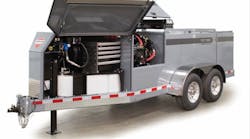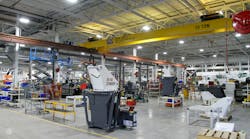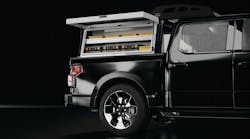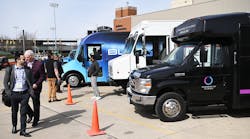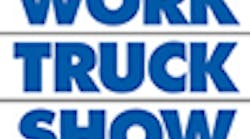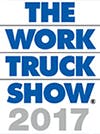Albert Bates returned to The Work Truck Show to talk about his favorite subject: making more money.
Using results from NTEA’s annual financial benchmarking survey, he laid out a plan to help companies devise a profit strategy for the future in his presentation, “Business Diversification for Long-Term Distributor Success.”
Bates said the typical distributor member of NTEA has $10 million in yearly net sales—meaning half of the companies do better and half of companies do worse, based on the survey.
He said the typical company’s gross margin of $2.2 million is too low and total expenses of $1.9 million (19% of sales) are too high.
“They are in constant conflict,” he said. “I do things that raise my margin, and that causes my expenses to go up. I lower my expenses and somehow I lower gross margin at the same time. We will fight a big battle on those two issues.”
He said $1.1 million of the $1.9 million comes from payroll and fringes (salary, bonuses, commissions, Social Security, 401(k) programs, and health insurance).
“It is the name of the game,” he said. “If we’re going to battle expenses, we have to battle payroll at the same time.”
The typical company’s profit is $300,000, or 3% of $10 million in net sales, which he says is “not terrible” but also “not wonderful.”
“I’d like to make it better if I could,” he said. “In this particular industry, we’ve kind of bounced around, but we’re a 3% industry. How can we make it better?”
Bates said that according to surveys over the last five years, profit before taxes (PBT) was 2.2% in 2011, went to 3.5% in 2014, and then came back down to 3% in 2015.
“It goes up and down over time, but it doesn’t go up a lot,” he said. “We’re stuck in a rut. We’d like to change the character of the business.
“The driver of profitability in distribution across every industry is what has happened to sales growth. It was as high as 15% in 2013 and dropped to 5% in 2015. We tend to be as an industry—and this is true to all of distribution—dependent upon the economy. Can we change the model so that we’re not always totally dependent on the economy? Can we do better on our own?”
He said that for the top 20% of this industry’s companies in profitability, the differentiator is that they have a much larger gross margin percentage: 29% instead of 22%.
“This is not minor,” he said. “We do surveys in 40 different lines of trade and distribution, and this is the biggest difference we’ve seen in gross margin of any segment we look at, so there’s something going on that we need to address.
“If I look at payroll and fringes, the typical company is 11%, to 10% for the top 20% company. And the top 20% company pays more on expenses (11% to 8%). But the top 20% company has a profit before taxes of $800,000, which is nearly three times the typical NTEA company ($300,000). This is a mega-number we have. Our goal today is to ask ourselves, can we in fact change the nature of this company? Can we move from a 3% bottom line to 8% bottom line? Are we willing to make the sacrifices to do that?
“Eight percent is not possible immediately. It’s probably going to take us between two and five years to get there. Most people want to do it right now. A one-year plan is phenomenal. It doesn’t work. I can’t do it in one year. I know because if you tell me, ‘Hey, I can go from 3% to 8% in one year,’ I’d ask you, ‘Why haven’t you already done it?’ Everybody’s working as hard as they can. It’s difficult out there. We’re going to set a goal. I’d like to get you to an 8% bottom line in say, five years. You say, ‘Oh, that’s way too long.’ I know most of you want to do it in one, two, three years.”
As part of his book, Breaking Down the Profit Barriers in Distribution, he did a research project in which he combined the results of 18 different industries in distribution, including the NTEA. He asked 900 companies, “What drives profitability?” He identified sales size (how big they are versus others in the industry), sales growth (how fast they are growing versus other people), gross margin percentage (the difference between what they buy for and sell for), operating expense percentage (expenses as a percentage of sales), day sales outstanding (DSO, how fast they collect bills), and inventory turnover.
“Of all the things that could drive our profitability, of all the things we could do better than our competition, the real key is doing better on gross margin and operating expenses at the same time,” he said. “If a company does better on gross margin, operating expenses and DSO, the PBT is 7.4% versus the overall industry average of 3%. If I do all five things better at the same time, I do worse than if I did three. That’s a little strange. It says, if I begin to try to do five on factors that really are important, I slide back to 6.9% PBT.
“A lot of companies tend to combine things together that do not have an impact on the bottom line. They combine inventory turnover with other factors and the answer is, it doesn’t drive profitability.
“There are some things that drive profitability. There are some combinations at the very top: gross margin, operating expenses, and something else. But nobody wants to do them or feels like they can do them. Why don’t we do them? If we are getting this message that the real key to profitability is to figure out a way to divide gross margin and operating expenses, why don’t we do that? The answer is, it is incredibly difficult to do.
“Some companies are able to get a higher gross margin, and when they do, their expenses tend to go up at the same time. If we’re going to track gross margin and expenses, they are joined at the hip. Some companies devise a strategy or approach or plan to increase their gross margin percentage, but when they do that, what tends to happen almost automatically is operating expenses go up at the same time. That doesn’t solve the problem. All it does is change the nature of the problem. You can be a high-gross-margin, high-expense company or a low-gross-margin, low-expense company, but you’re still a 3% bottom line company.”
Bates said his goal for industry companies is to join the 50-50 club: be in the upper 50% in gross margin and upper 50% in operating expenses (meaning lower expenses) for a 6.5% PBT. The next-best thing would be to join the 40-40 club: better than 60% of your peers on both gross margin and expenses simultaneously, which produces 10% PBT. But only 2% of companies get there.
“Driving a higher profit requires focusing on the right things,” he said. “Those are gross margin and operating expenses simultaneously. This is the always the challenge. It doesn’t say that sales growth is unimportant. Or that sales size is unimportant. But they don’t make a lot more money.
“What gets in the way of gross margin? We’ve done creative research. We asked, how good is this company doing in profitability? To what extent am I in a commodity business? This is subjective. The second factor is, to what extent do I have barriers to entry in my particular business? As I understand it, it is not that difficult to get into this business. I need to build some barriers to entry that say, ‘Strategically, structurally, it is difficult to do what I do.’ How do you do that? You need to identify, where do you want to be in life? On the continuum, price-firm companies are ones that like to operate on low price and low service. There are companies in the middle, and then service-firm companies on the right. The money is not made in the middle.
“If I’m going to be a service firm, my expenses are going to be high. This is the most difficult challenge that companies face.
Bates said the personnel productivity ratio (PPR) is a “crucial ratio.” It’s the percent of each gross margin dollar that must be devoted to payroll. Of the total expenses, payroll is the biggest cost, so the idea is to relate payroll generated during the year to the gross margin generated.
He said the typical company has a payroll of $1.1 million and a gross margin of $2.2 million, for a PPR of 50%.
“It’s too high,” he said. “I’d like to, over time in this industry, drive this number down into low 40s. I’d like to see it somewhere between 40% and 42%. There are two ways to do it: lower the payroll numbers or raise the gross margin.
“My plan is that over time, I would like to have your sales grow faster than your payroll. This sounds simple. But it is brutally difficult to do. For example, in a slow-growth year in 2015, sales grew by only 5%. I would like payroll to grow by 3%.
“If I look at old surveys and check payroll as percentage of sales 20 years ago versus today, I find it’s the same number. We’ve done all sorts of things different and better, but we haven’t been able to control payroll as a percentage of sales. Over time, payroll and sales go up together. Not every year. But over time, they go at same rate. Half of the time, net sales, cost of goods, gross margin, and all other expenses go up by 5%, payroll by 3% and total expenses by 3.8% for a net profit increase of 12.3%. But for the other half, payroll and fringes go up by 7% and total expenses by 6.2%, and net profit goes down by 2.3%.
“Over time, payroll is probably going to go up, but we’re going to figure out how to make it go up slower than sales. It requires you to think about sales and payroll simultaneously.”
Bates said the key is to find areas where you can raise prices and “get away with it.” And the answer is found in slow-selling items.
“When do people buy them?” he said. “When they absolutely have to have them. You bring the added value to the party because you have them when they need them. Most distributors underprice the slow-selling items. Raise the price on those items by 10% and see what happens. In a typical company, gross margin can go from $225,000 to $275,000 per year. The problem is, most people are afraid to raise their prices on those items.
He said that in order to raise the prices and “get away with it,” companies need to find SKUs that have four or more of these characteristics:
• Low sales level. Bought rarely, unlikely to remember the last price paid.
• Not heavily promoted. Information about price is not readily available.
• Bought only when needed. Availability is more important than price.
• Low price. On a small item, no real concern about price.
• Repair parts. Buy something small, avoid buying something large.
• Unusual. Hard to find; availability is the key.
• Non-seasonal. No need to discount “in season.”
• Unbranded. Difficult to obtain specific price information.
He urged companies to make a plan. The numbers can be slightly different than his, but here is Bates’ plan:
• Increasing sales by at least the inflation rate plus a safety factor of 3%.
• Force payroll to grow slower than sales to create a sales-to-payroll wedge of 2%.
• Increase the gross margin percentage (not gross margin dollars) by 5%.
• Decrease the other expense percentage (not expense dollars) by 3%
“If we work relentlessly to accomplish this in our business, what would happen?” he said. “Within five years, profit before taxes goes from $300,000 a year to $1,022,105. That is a mega-change in our business.” ♦
